By Jeffrey A. Rendall, Photos By Larry Lambrecht and David Vier
Ed Note: GolfTheMidAtlantic.com would like to congratulate Fred Funk on his victory in the 2005 Players Championship. This profile was released the week prior to his victory at TPC Sawgrass, and contains some of Fred's thoughts going into the tournament, and suggests, in his words, how he was able to win in such dramatic fashion.
PONTRE VEDRA BEACH, FL – It is one thing to say that you want something, it’s an entirely different matter to actually put in the work to accomplish it.
PGA Tour player Fred Funk (originally from College Park, Maryland) is one of those people who recognized his talent for the game of golf, then worked diligently to improve and realize his goal of playing on the PGA Tour.
The fact he’s become one of professional golf’s most recognized and beloved players is a bonus – it’s all part of a personality that draws people to him, easily seen on the television screen or in person.
Funk began his professional golf career as a teacher at the University of Maryland, where he was the school’s Golf Coach from 1982 to 1988 – but it was always his goal to keep getting better and eventually play full-time on Tour.
“My game got better as I was coaching,” Funk said, “and I started to consider whether I could make the Tour or not, so I kept going to Q-School. I just wanted to see how good I could get, and that’s still my goal every day – to try and take what I’ve got to the Tour and see what happens.”
It took him four tries to break through, earning his first card in 1989, only to fail to keep it during his rookie season on Tour. He went to Q-School for a fifth time and passed again, and he’s been playing with the best players in the world ever since 1990.
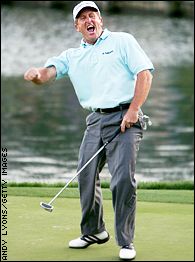 |
| Fred Funk celebrates after draining his final putt on the 18th hole at TPC Sawgrass. It wasn't over at that point, but everyone knew there was a great chance that he'd pulled it off. Photo from ESPN.com. |
Perhaps it’s because Funk was already mature when he reached the top level that he’s been able to maintain the enthusiasm to keep playing and competing at age forty-eight. And it’s only been in recent years that he’s really reached stardom, beginning with the 2002 PGA Championship at Hazeltine National Golf Club in Minnesota, where he contended until the end -- and the national audience first noticed the qualities that had always made him popular to the fans who knew him.
Since Hazeltine, Funk’s starred in commercials for the PGA Tour and played well in more important events – last year he played alongside Phil Mickelson in the second-to-last pairing at the US Open, getting a chance to witness the dramatic finish first-hand. He was also chosen by team captain Jack Nicklaus to play on the 2003 United States President’s Cup Team, and made the 2004 US Ryder Cup Team on points.
So Funk’s been around. We were able to catch up with him after the Ford Championship at Doral, and he was kind enough to give us the ‘Funk perspective’ on life as a crowd favorite as well as his thoughts on the state of professional golf today:
GTMA: Certainly in recent years, you’ve received quite a bit of attention as one of the ‘stars’ in the game of golf. For those years previously, would you have described yourself as a journeyman player?
Funk: I probably still am, really, but I guess I’m also one of the so-called ‘fan favorites’ that the media likes to focus on. It’s probably because I’ll interact with the crowd and stuff, you know, show my emotions a little more.
They seem to have adopted that title ever since the PGA at Hazeltine a few years ago, although I don’t really do anything different than I ever did. I’ve always enjoyed the people – but I guess that was the starting point, being in the second-to-last group with Tiger in the big atmosphere and all that.
GTMA: And then Jack picked you to go to South Africa to compete in the President’s Cup in 2003 – which confirmed your place as one of the country’s premier players. What was that like?
Funk: It was fabulous. On points I finished 11th, and I thought it was such an honor that Nicklaus picked me – that he thought I was good enough to be a part of his team, and represent the country overseas.
It was a great experience, the first time I’d been to South Africa. The atmosphere there, representing the country and your teammates – it was really, really good. And all the team activities were fun as well.
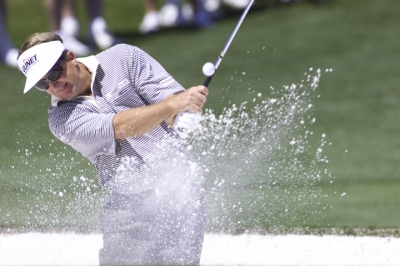 |
| Fred Funk blasting out of a bunker at Augusta. Photo By Larry Lambrecht. |
GTMA: How would you compare it to playing in the Ryder Cup?
Funk: The intensity level was notched up astronomically at the Ryder Cup. Everybody had told me that, but I guess you don’t believe it until you’ve gone through it.
I guess it’s because of all the history associated with the Ryder Cup, and the President’s Cup is still relatively new. There’s certainly a lot of pressure in the President’s Cup, but it’s not as high as it is when playing the Ryder Cup Matches.
GTMA: Is there more animosity between the teams in the Ryder Cup because it’s really more like two different Tours competing against each other?
Funk: That may have been the case years ago, but I don’t think it’s true anymore. Most of the guys on the European Team play over here full-time now, or you still see ‘em an awful lot. So it’s not really strangers against strangers.
It is different countries against different countries, that’s all it is.
It’s not so much that you don’t know those guys, because we all know ‘em really well – but you still want to beat them. And the fact they’ve gotten the best of us in recent history… it’s something you take to heart and you want to be on a winning team.
I think, from top-to-bottom, the International Team is probably stronger then what the Europeans can throw at you – but the Europeans have just done a great job of beating us. For whatever reason, they’ve got our number right now.
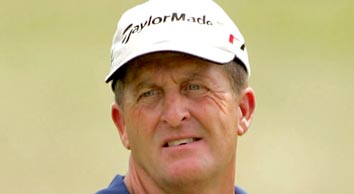 |
| From the Ryder Cup Official Website. |
GTMA: What’s your take on last year’s Ryder Cup – did you always feel like the team could come back?
Funk: Well, after the first day, we really knew we were in a hole (Europe led 6 ½ - 1 ½ after the first day’s matches).
We started to make a little bit of a comeback early on Saturday, when it looked like we might win 3 out of 4, or even 3 ½ out of 4. Then it ended up being 2 ½ to 1 ½, so we didn’t get nearly the push out of that that we were hoping for.
Then they slammed us again in the afternoon, and it was a runaway at that point. There really was no way for us to come back with the lead they had (Europe was up 11-5 at the end of Day Two).
On paper, it was the biggest defeat in history. The final numbers were huge (18 ½ - 9 ½), but eleven of those matches went down to the final hole – and we only won one of them. That’s pretty telling right there, on how it could’ve gone one way or another, just from the 18th hole alone.
GTMA: As far as the format of the matches – do you like the fact there are more matches in the President’s Cup versus the Ryder Cup?
Funk: I like the fact that you can’t hide a player in the President’s Cup, because everybody plays. It’s nice to be involved in every match in the President’s Cup – you can’t bench a guy and hold him out until the Sunday Singles matches. I like the fact it’s more like a total team effort that way.
But if you wanted to add more matches to the Ryder Cup, it’s almost like you’re changing history. It wouldn’t be fair for me to answer that, comparing the two formats, or to say which one’s better, because there’s history and tradition to consider as well.
GTMA: There was a lot of talk after the matches last year about how the European team had an edge because a lot of their guys had won tournaments in recent months going in. As a result, the PGA of America changed the weight of the points to give a greater emphasis on winning events. Do you think that will improve things?
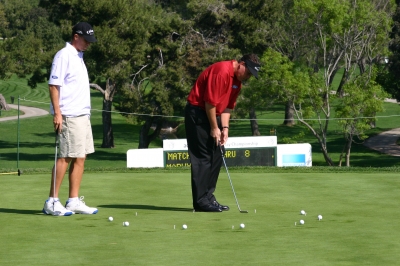 |
| Funk was paired alongside Phil Mickelson during the dramatic final round of the 2004 US Open. Photo By David Vier. |
Funk: I don’t mind that at all, that’s fine. I also don’t think it would’ve changed our team that much, one way or another.
All the guys from eight down to twenty-two, twenty-five guys could’ve been inter-changeable on the US Team, pretty much, based on how they’d been playing leading up to the Matches -- and every one of ‘em would’ve been a deserving member of the team.
There were four or five guys on the European Team that were just playing really well at that time, and a couple had breakthrough years – namely Luke Donald. And obviously they had Sergio Garcia and Colin Montgomerie and Padraig Harrington… and Thomas Levet had just won recently.
They had numerous guys who were at the tops of their games.
GTMA: So they had momentum. The US Team still had tremendous talent – what made the difference?
Funk: If anything, we played uptight. That was the theme of our Captain, Hal (Sutton) – of not being uptight, just being out there and going for it.
But once that gun sounds, you just feel like… we felt like we needed to win, and we wanted to win so bad. I think we all just felt a little bit too much pressure. And then we got smoked that first day, and the heat was really on after that point.
GTMA: Do you think the ‘tightness’ will carry into 2006 over in Ireland?
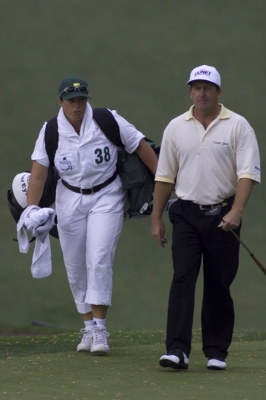 |
| Fred Funk's become a regular at Augusta. Here, walking its finely manicured fairways. Photo By Larry Lambrecht. |
Funk: One of the worst feelings I’ve ever had was on the 18th hole during my match with Thomas Levet on Sunday, after the outcome had already been decided – and trying to finish the match while they were celebrating out in the fairway and all that stuff.
They were pretty rowdy and didn’t have any control over the situation. There was no satisfying feeling on our side. That was not a good feeling, and I’d love to put it back in their faces over there, and be able to celebrate on their soil.
Whether I’m on the team or not, I hope our guys do that.
GTMA: Switching gears a bit – Jack picked you and Jay Haas for the 2003 President’s Cup team, and Gary Player picked a couple ‘young’ guys. Nicklaus decided to go with experience, and part of that was because there’s a group of ‘over 45’ players who are playing really well. What’s allowing you and guys like Jay Haas to keep it going longer than in the old days?
Funk: I think it’s a question of motivation. Some people have said it’s improvements in equipment, but the golf ball doesn’t know how old you are.
If you’re motivated to play and keep yourself in some sort of physical condition, there’s no reason why you can’t still go out there and shoot numbers.
In Jay’s case, he’d had a couple down years before his resurgence – he was a little burned out, and decided it was time for him to finish his regular Tour career in style and he’s really stepped up his game. His putting has really improved and his ball striking is the best it’s ever been. He’s just very motivated right now, and that’s the difference.
For me, I’ve always been motivated, trying to improve, and I still feel like I’m getting better right now. I still feel like there’s a lot I have to learn and areas I can improve on, and I’ve just got to go do it.
At my age, if you’re not motivated, the young guys will just run right over you.
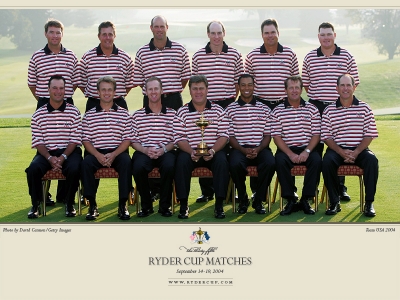 |
| The 2004 US Ryder Cup Team. Photo from the Ryder Cup website. |
GTMA: One advantage you’ve always had is driving accuracy -- last year you won your seventh Tour Driving Accuracy title, and third in a row. From your personal standpoint, does that mean you like to see course set-ups with high rough?
Funk: I can’t compete on golf courses with real wide fairways and no rough, because the bombers will just take over.
I don’t usually mind long courses – I just need ‘em set-up right. It’s not necessarily narrow fairways and high rough, but there’s got to be something that’ll penalize you when you’re off line.
But even then, it doesn’t seem to matter for this current group of top players. If you look at the Doral statistics, Tiger and Phil were almost last in driving accuracy, yet finished first and second. Granted, the rough was deep in spots there, but the guy who finished on top in driving accuracy, Billy Mayfair – he still was well back at the end.
There’s no substitute for length. I need to be accurate to even compete, but I’ve got to be hitting on all cylinders to have a good week – putting well and driving it in the fairway. And there doesn’t seem to be a rhyme or reason as to which courses I play well or I don’t. If my game is on, I’ll play well no matter what kind of golf course it is.
GTMA: How much of the long hitters’ advantage is exaggerated by the new equipment?
Funk: That’s the sad thing in the state of the game right now – that they guys who were long hitters to start with are just so much longer with the new equipment, because the harder you hit the ball, the more speed and the higher you hit it, the farther it goes.
The guys who hit the ball long to start with have gotten this exponential gain. Where I’ve picked up a little bit of yardage, they’ve picked up a ton.
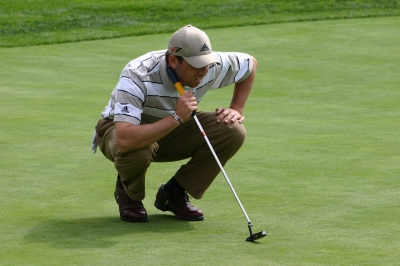 |
| One of Funk's European Ryder Cup opponents, Sergio Garica. Photo By David Vier. |
The technology’s created more of a separation between the shorter and longer hitters – most of it’s the ball right now. It’s so aerodynamically good, it just doesn’t fall out of the sky.
GTMA: How do you feel about having a tournament-spec ball?
Funk: I’d like to see them slow down the ball a little bit, to two ball generations ago, before this last set of balls came out. Those golf balls didn’t make the gap between long and short hitters so dramatic – everybody had more of an even playing field.
This last generation of balls, the distance just spiked – eight, ten yards out there, on average. Now you’ve got so many guys who can hit it 300-yards in the air, it’s a joke.
GTMA: You see it when guys are starting to consider 370-yard par fours as drivable, like the 16th at Doral.
Funk: A handful of guys can really overpower every golf course.
The top five players in the world (speaking of Tiger Woods, Vijay Singh, Ernie Els, Phil Mickelson and Retief Goosen) are all overpowering players. They can overpower any golf course, and out-finesse you, too. They have the total package.
But the biggest thing they have in common is they can all hit the ball a long, long way. You can’t be a top player in the world without having some sort of freakish power.
There are a couple exceptions, but even then, only to a point. Take David Toms for example. He hits it farther than he’s given credit for, but he’s not nearly as long as those top five guys. Or Mike Weir.
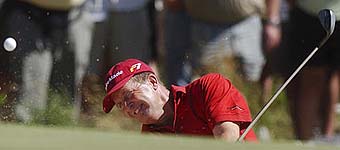 |
| Fred Funk at the 2004 US Open. Photo from ESPN.com. |
And most of the other top ranked players also really hit it long. Sergio hits it long, and he’s sixth (ranked). Padraig Harrington hits it a ways, and he’s seventh. Stewart Cink hits it a long ways and he’s tenth.
To be a top ten player and not be overwhelmingly long – well, you’ve just got to be hitting on all cylinders for a lot of weeks. You’ve got to have the overall game, you’ve just got to have more of it more often.
Tiger can be off on other parts of his game, and something’s going to work or not work for him every time out. But he can always overpower a golf course and pick and choose how he plays it. When he’s reaching 600-yard par fives in two, that’s pretty amazing.
GTMA: You certainly played well at last year’s US Open, on a very difficult golf course set-up at Shinnecock Hills. There were many players who said it was unfair. What are your thoughts on that?
Funk: The golf course was perfect on Thursday and Friday. They started losing control of it on Saturday afternoon, then on Saturday night the winds blew about 30 mph and really dried the place out.
Sunday, it was gone.
The USGA knew it was coming, but they did their typical head-up-the-rear-end set-up on Sunday. They just don’t seem to get it, doing the same thing year-in and year-out. They take a great golf course and they’re so worried about protecting par that they turn it into ‘goofy golf,’ and that’s what it was on Sunday at Shinnecock Hills.
GTMA: That bad?
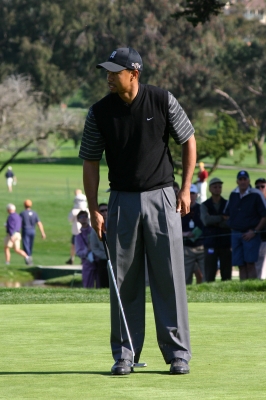 |
| Tiger Woods at the Accenture Match Play. Photo By David Vier. |
Funk: It was a weird day because I got to the golf course and saw guys turning in 47, 45, 44. The best players in the world are shooting bogey golf or worse on nine holes, and you’re going ‘Jeez, if these are the morning scores, who knows what it’s going to be like in the afternoon?’
It wasn’t very fun on Sunday.
It was fun being in the atmosphere, playing in the second-to-last pairing with Phil. But as far as rewarding good golf shots, that really wasn’t happening out there. It was just a survival test.
GTMA: You guys had it rough, but it was great theater on TV – at least until the 17th hole. The air went out of the proverbial balloon there. Anything that happened there that wasn’t apparent just from watching it?
Funk: Phil got a lot of criticism for three-putting from where he did, but where he left it out of the bunker, he knew he was in trouble. If he missed the par putt, it was going to go six or eight feet by, no matter how hard he’d hit it.
What nobody wrote about was his lie in the bunker. A lot of the bunkers had little stones in them, and every now and then you’d get a stone between the ball and the club, and the ball would come out without any spin – and that’s what happened to Phil on 17.
He hit a nice bunker shot, it came out soft and landed where it should have, but it didn’t have any spin and it released past the hole – which was the last spot you wanted to leave it, because it was such a downhill putt.
The same thing happened to me twice that week. It’s just unfortunate that it happened to Phil at that moment.
He’d just finished making a beautiful birdie on 16 to tie the tournament, and I told my caddy ‘He’s got this thing, he just won with that birdie.’ And then he – I call it – he got ‘stoned’ on 17 (chuckles).
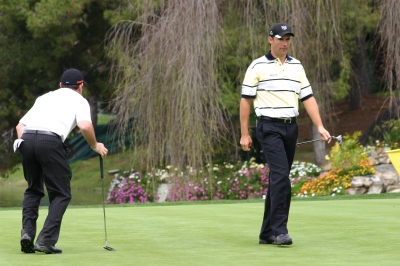 |
| Padraig Harrington won the Honda Classic. Another world top-ten player who hits it long. Photo By David Vier. |
It was just a tough, tough day. I think I shot what, 77? And that was one of the better rounds that day. It was amazing.
GTMA: Speaking of US Open-type tests, the Washington area’s own Booz Allen Classic is moving to Congressional Country Club’s Blue Course this year. Being from around there, is that exciting to you?
Funk: Yeah, it’s exciting for everybody. There aren’t many Congressional Country Clubs in the world. It’s a very special golf course – a very special atmosphere.
I feel bad that the tournament doesn’t get enough credit for the years it’s been at Avenel, because Avenel’s turned into a pretty good golf course – and the changes they’re planning to change it will only make it better.
But no matter what, there’s no golf course in the Washington area that has the clout that Congressional carries. It’ll be a banner year for the tournament this year, or any season that it goes to Congressional, just because of the reputation the club has with the players.
It’s a very, very special golf course.
GTMA: The tournament’s slot, right before the US Open at Pinehurst, probably doesn’t hurt either. Do you think we’ll see the top players at the Booz Allen this year?
Funk: Yes, I do. I think they’re going to have a ridiculously strong field. In fact, I’ll bet that Tiger plays. He usually doesn’t play the week before a major, but I’ll bet, because it’s Congressional, that he’ll show up.
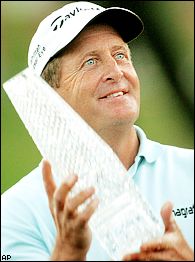 |
| Funk was speechless after winning the Players Championship. He's always been humble about his golf game, but he's a worthy champion. Photo from ESPN.com. |
I’ll bet four out of the top six in the world are going to be there. Or maybe even five.
GTMA: Is it the timing, or Congressional that’s bringing ‘em out?
Funk: Both, but mostly because it’s at Congressional.
GTMA: What’s your favorite aspect of Congressional? Why is it that different?
Funk: When you’re playing there, it feels like a major, because they’ve had majors there. It’s got that great look and feel – you feel like you’re playing somewhere very special.
That feeling’s there, even when you first drive in, just seeing the clubhouse and the golf course. It just has a certain aura around it that not many clubs have. You get a special feeling when you drive into Augusta, and you have a special feeling when you drive into places like Cypress Point... And I get that same feeling when I drive into Congressional Country Club, even though I’m from around there.
GTMA: The US Open’s at another special place this year, another regional golf course at Pinehurst #2. What are your thoughts on that?
Funk: Pinehurst is a beautiful place, and they did a great job setting it up the last time we were there, when Payne won in ‘99.
I hope the USGA doesn’t go crazy with the pin placements. They have a tendency to put the pins on places where the greens fall-off, and on a course like Pinehurst #2, that can be unfair. Those greens were not designed to run the speeds they’re doing today, like a 12 on the stimpmeter. They were designed for more like 8 or 9.
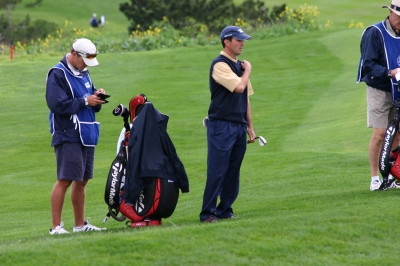 |
| Mike Weir gets it done with sneaky power and a superb all-around game. Photo By David Vier. |
The USGA tends to put everybody on defense a lot. You can’t be real aggressive or you’re going to roll it right off the green and make a fool out of yourself. And the USGA likes to see people make fools of themselves, so they put everything right on the line.
US Opens are never any fun. Maybe for the one guy who wins it, but I wouldn’t even say that he’s had much fun out there, it’s such a pressure packed week. And the golf courses are so hard the way they set ‘em up. It’s just a test of patience.
The USGA is too concerned with protecting par, and it just isn’t that way with the other majors.
GTMA: Wrapping things up, I really enjoyed your PGA Tour commercials with your son in the ‘Andy Griffith Show’ theme. Were you a fan of the show?
Funk: It was one of the shows I watched growing up as a kid, and when they asked me to do it with my son as ‘Opie,’ it was a slam dunk. A lot of fun.
Watching Fred Funk is a lot of fun, and it’s not just because he’s from the DC area. He’s a guy with a golf game we can truly emulate, because he doesn’t blast it into the lower atmosphere, he just hits it in the fairway and plays golf courses the way they’re designed.
Funk says ‘stardom’ has come at a price, mostly dealing with fans’ expectations. “I appreciate people who support golf, and we’re in the entertainment business, I realize that. It’s just hard to be ‘up’ when you’re not playing well – and ever since I had that run at the PGA a few years ago, the people expect me to be ‘up’ all the time,” Funk said.
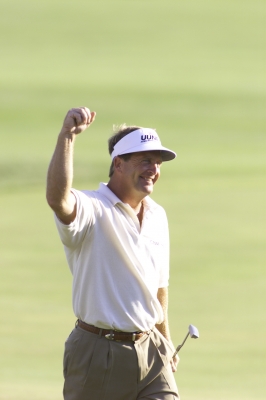 |
| Another look at Fred Funk at Augusta. Photo By Larry Lambrecht. |
Fred’s human, but that’s perhaps what’s best about him. And another place we hope to see him ‘up’ is on the weekly leader board.
Note: Our thanks to Fred Funk and his caddy, Mark Long, for granting us this exclusive interview. Additional thanks to Mark Maier for helping to make the connection.
Details:
For more information on Fred Funk, I’d suggest you try the PGA Tour’s website: http://www.pgatour.com/.
Congratulations to Fred Funk and Mark Long on the big win at Sawgrass. It looks like we'll be seeing Fred on Tour for many years to come!
| Related Links | Comments on this article? | |
|
Maryland National Golf Club Hollow Creek Golf Club Rocky Gap Resort PB Dye Golf Club in Ijamsville Whiskey Creek Golf Club |
E-mail Jeff Rendall, Editor: jrendall@golftheunitedstates.com |











